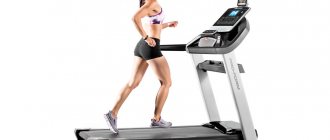Running is one of the most popular types of training, apparently because no special equipment is needed. Put on your shoes and run.
Most people start running to achieve their dream figure, but remember that running is not the best way to lose weight and generally does not help build muscle mass, unless of course it is training for a 100-meter sprint.
But despite the bright prospects, not everyone is running. It’s incredibly difficult for many – muscles and joints ache, the lungs contract from tension, the mouth becomes dry, and other unpleasant symptoms arise, including fainting. And all because, although this is a very natural thing, you need to be able to do it - study and hone the technique and know about a lot of subtleties.
How to run correctly: safe running technique
Let's try to describe the correct running technique as simply as possible: running is a constant fall forward, you fall and put your feet up so as not to fall - thus, you save strength due to the energy of the fall, which partly moves you forward.
You need to place your feet under your falling body correctly: land on the ball of your foot, ideally exactly under the center of gravity of your body. With perfect landing technique, you can run even on slippery ice.
The “cadence” in running (number of steps per minute) is usually too small for beginners (too long, sweeping steps, jumping too high), you should strive to move your legs more often (about 90 steps per minute), take fewer steps.
Your arms should move along your body, bent at right angles, as if you were holding a towel thrown over your neck by the edges.
That, in fact, is the whole science of running, and now all this is much more detailed:
Here is the technique for performing one running step. There are many nuances, but not all at once. Master these tips one or two at a time, gradually developing the skill of correct movement. It would be optimal to hire a coach to set up the correct running technique. Zozhnik recommends, for example, the trainers of the Trifit studio (this is if you are in St. Petersburg). Our experience has shown that it is more effective and cheaper to take two or three personal training sessions from the best running coach and then follow an individual program written by him, than to do seven weeks in a group.
Clicking on it will open a larger picture.
At the start of each step:
- bring your leg straight out in front of you;
- look forward and keep your head parallel to the ground (imagine that there is a plate on the top of your head);
- bend your arms at an angle of 90 degrees or slightly less;
- don’t slouch, straighten your shoulders (this also allows your lungs to open up and work more efficiently);
- keep your knees soft.
In the air:
- do not wiggle your hips: you are running, not dancing, running should not look sexually provocative;
- work your hands clearly back and forth, do not swing them in other directions;
- keep your shoulders back and don't squeeze them;
- bend your knee and ankle joints at an angle of 90 degrees.
Near the ground:
- shorter step: feet should land directly under the buttocks;
- keep a vigorous rhythm (count how many times your foot touches the ground), your goal is 85–90 times per minute;
- land on the middle of your foot, do not drive your heels into the ground (if you are jogging at a leisurely pace, gently place your foot on your heel and roll onto your toes);
- After your foot touches the floor, tighten your glutes as you take your leg to the next step.
Footwork and foot placement
Running speed determines the height of the knee lift - the higher the speed, the higher the knee rises. Speed indicators are affected by step frequency.
A very important point is the correct placement of the foot on the surface. Depending on the individual characteristics of the runner, there are 3 methods:
- Heel-to-toe is the most popular method, used by long-distance runners and those who take leisurely runs. Once your heel hits the surface, you need to maintain tension to prevent shuffling and injury to your foot.
- From the toe - used at medium and sprint distances, when you need to develop maximum speed. This kind of running requires developed leg muscles.
- Running on the outside of the foot - when done correctly, allows you to reduce the impact force when the foot touches the surface, but it is too early for beginner runners to master this technique.
There is no need to powerfully and sharply lower your knees, “driving” your feet into the surface. Such a heavy load is fraught with knee injuries, even with super shock-absorbing running shoes. Also, you don’t need to fully straighten your knees, they should be slightly bent to allow springing.
It is difficult to describe the movement of a person’s legs while running; the easiest way is to call them circular. After the lower leg pushes off the support, it moves upward, bending the knee joint. The energy is then transferred to the hip, which moves forward. After this, the movement goes in the opposite direction. It is important to understand that when running, the leg does not work as a cast flywheel, but as a set of joints. The foot should be placed on a support under the center of gravity, and not in front.
Beginners to running are advised to immediately learn to run correctly; this will not only save energy and reduce the risk of injury, but will also make the activity more comfortable. The correct running technique does not consist only in the movements of the arms and the position of the body and legs, it is also necessary to learn the correct breathing technique and learn to control the heart rate.
Exercises that will improve your running technique
1. Changing running poses with your back to the wall
- Goal: learn to pull the heel in the right direction - under the pelvis, so that the leg does not remain behind and does not whip too far forward.
- Execution: stand with your back close to the wall. Jump from foot to foot, making active movement in the limb you are lifting from the ground, and not in the one you are about to place.
2. Running in place
- Goal: understand that until you tilt your body, you will not move forward. And secure the position when the legs remain under the pelvis.
- Execution: remember exercise 1 and using the same principle, simply run in place: pulling your heels under your pelvis and raising them to a comfortable height - approximately to the middle of the shin.
3. Falling on a wall
- Goal: learn to “fall” forward, keeping your body straight at all times.
- Execution: stand in front of a wall, knees slightly bent: they should be over your toes. The weight will shift to the front of the foot, the pelvis will be over the support, and the shoulders will be over the pelvis. Fall on the wall and rest your hands on it: make sure that your pelvis is not behind.
- When you get the hang of it, you can try this chain. Changing running poses against a wall - running in place - falling on a wall - running with the addition of falling forward. Over time, you will feel that the greater the slope of the fall, the higher the speed. Make sure that the pelvis does not go back, the shoulders do not fall forward, your position remains collected, there is no swaying from side to side, the body does not twist with the arms, the movements are light and smooth. Keep your head straight, don't nod.
4. Running with arms extended forward
- Purpose: to check how correctly the body works.
- Execution: Stretch your arms in front of you and fold your hands. If they start to “walk” while running, you are doing something wrong. Level yourself up, try not to wobble.
What is natural running?
Simply put, this is running barefoot - this is what man did in the process of evolution. During the transition to walking upright on 2 legs, a foot with a natural shock absorber was formed - pronation and supination.
To feel this, try jogging barefoot. You won't be able to run on your heel because of the pain, and you will quickly adapt to that very natural running. To avoid pain, the technique will begin to change: the step will decrease, the leg will no longer be thrown forward, the landing will be on the wide part of the foot - the base of the toes, the arch of the foot will begin to tense and absorb the impact of the landing. Proper running technique and natural running are one and the same.
Proper running technique is not running on your toes! Heel running and toe running are two extremes. Correct landing should occur on the wide part of the foot at the base of the toes. Then the heel strikes if you run slowly. When sprinting, your heels do not have time to touch the surface.
A sedentary lifestyle and the wrong shoes do not allow the natural “suspension” to form. Gradually, the foot loses its ability to absorb shock. The load is transferred to the knees, spine, ligaments and tendons. The end result is injury. To correct such a foot, you need to train long and hard.
Notice how skillfully this 9-year-old boy runs. The body is genetically configured for natural running; all that remains is to use this skill correctly.
How to run correctly: pace and duration
Often, neophytes start too quickly and quickly leave the race with injuries and the belief that running is evil. In fact, it’s evil not to understand at what speed and for how long you need to train.
If you can easily carry on a conversation while running, then you need to increase your speed. But wheezing on individual words is also wrong. The optimal speed is the golden mean between these extremes, when you can speak, but not eloquently, but in short sentences. In numbers, this is approximately 5.5 – 7.5 minutes per kilometer, depending on the level of training.
Start getting into running by jogging for 20 minutes three to four times a week. Don't worry if you need to step up when things get tough in the first few months. Your goal is to gradually reduce rest periods and increase your running pace. If you are an absolute beginner with no contraindications to running, then after 10-12 regular workouts you should be able to run at a calm pace for 30 minutes without a break.
Only when your running pace is in the range of 5.5-6.5 minutes per kilometer and you can maintain it for at least half an hour, gradually add running exercises.
- After warming up and 10 minutes of continuous running, do 20 seconds of maximum acceleration, then 10 frog jumps or just low jumps. And so four times in a row. At the end of the workout, perform dynamic stretching exercises (several swing and amplitude movements) and walk at a brisk pace for 10 minutes.
- Run uphill for 30 seconds, jump low in place 10 times, or do 10 jumping jacks if you feel strong. This is 1 approach, do 3. After – dynamic stretching.
Every week or two, add 10 seconds to your intense interval. And try to finish your workout with the intention of running a minute longer next time, rather than wishing you could die in a puddle of sweat at the finish line.
How to start running
Now you know how to run correctly, then you need to move on to practical exercises. You need to build momentum consistently, so don't chase speed or run time. Now the main thing for you is quality and correct technique.
Start by jogging.
Program for Beginner Runners
It is advisable that a trainer develop a training plan for you - he will take into account your initial data, physical fitness, and health characteristics. And he will monitor the implementation of the plan. But if you don’t have an experienced mentor, you can stick to the average program.
Training program for beginner runners.
The data is approximate. You can change them smaller or larger, depending on how you feel.
The most important rule: at the initial level of training, you should combine running with walking:
- in the first week, 1 minute of running, 2 minutes of walking.
- in the second week, 2 minutes of running, then the same amount of walking.
- in the third week you need to run more than walk - run 3 minutes, walk 2 minutes, etc.
Indicators should increase gradually so that the body gradually gets used to physical activity.
Training pace
You're still learning to run, so keep it at a pace that's comfortable for you. Training too aggressively can lead to injury or rapid exhaustion, causing you to become disillusioned with running and give up on it.
Approximate speed: 5-7 minutes per 1 km.
Try talking while running:
- If you can talk freely, then you need to run faster.
- If the words come out of your throat sharply, with wheezing, then you have taken the pace too fast.
Stick to the middle where you can speak in short sentences.
Duration and frequency of classes
You need to train 3-4 times a week for 20 minutes.
You don't need to expect to run non-stop for the entire twenty minutes. We ran or walked, caught our breath and gave our bodies a rest. We started running again.
Try to reduce your rest periods over time. After 10-12 workouts, you can reach 30 minutes of non-stop running at a calm pace.
How to run correctly: run longer
When you run, your lungs, heart and muscles work hard, but running also puts a strain on your brain. From the moment you lace up your sneakers until the end of class, your gray matter is actively involved in the process. To prevent it from forcing you to end your workout early, listen to psychology doctor Jeff Brown from Harvard University:
Visualize your success Athletes who visualize how they have achieved high results are more demanding of themselves and train more intensely. Before you run, dream about how you cross the finish line of some competition that is important to you with a smile on your face.
Find words of support Come up with a catchy slogan and repeat the cherished words when you want to tell everything to hell. For example, “I’ve had harder times” or “I can do it, I’ll do it, I have the strength!” If only you yourself believed in the mantra, and it inspired you.
Deceive yourself If you are reluctant not only to exercise, but even to look outside, then convince yourself that you are going out for only 3 minutes. You will see: as soon as you start jogging, the desire to turn off the straight path will disappear. And if not, then your goal does not inspire you and you need to come up with another one.
Smile If not from the heart, then at least bare your teeth fervently. This will add confidence in your own abilities and help you not to whimper at the finish line.
Don't run every day We all know that for good results you need to constantly train. Each activity is a jolt for the muscles, bones, joints and ligaments, and the more often you expose them to dosed stress, the more resilient they become. But it is important not to overdo it with loads. By alternating monotonous running with interval running too often or going too fast, you risk injury.
The ideal regime for those who have recently started is 3 races per week. If you train less often, progress will crawl like a snail, and you will run like the first time every time. And if you increase the load, the body may not have enough time to recover. One thing: those who have neglected physical education for years and are significantly overweight should limit themselves to two races a week and add one or two walking or cycling walks. But in general, before engaging in health-improving physical education, each person needs to undergo at least a minimum medical examination and consult a doctor.
If you've already been running three days a week for a month and a half, you can add a fourth workout. This is the optimal mode for most (except when preparing for competitions). There is no need to add a fifth day. It’s better to do 4 classes a week with full dedication and gain strength for new feats. A good athlete is not one who runs every day, but one who is able to overcome long distances without injury. When increasing the effectiveness of monotonous training, keep in mind that you should not increase either the mileage, the number of workouts, or the running time by more than 10–15% per week.
And remember: excessive running load is just as harmful as its absence.
Five rules of running
For beginners, it is important to do everything correctly, then jogging will become not only a useful activity for you, but also a pleasure.
Proper running is systematic and measured. You can’t run a sprint or marathon for the first time. You need to approach everything gradually, thoughtfully. Next, we will give the basic rules on the basis of which you can create a competent running program for beginners.
Rule 1: The first workout is the shortest
When you first go out for a run, limit yourself to 10 minutes of jogging. First, walk briskly for 3-5 minutes, then start running. Your heart rate will increase significantly and your breathing will become faster. Perhaps shortness of breath will appear - you will gradually get rid of it.
If you find it difficult to run, reduce your speed to a minimum, but run. As long as you feel the strength, don’t start walking. Even if you run slower than you would walk, you still need to run. If you feel that your heart is jumping out and you are suffocating, it’s time to take a step. After you catch your breath, try to start running again.
Running for beginners should always be dosed.
After a critical load of “I don’t want to”, your body may fail. And if the muscles definitely hurt, even if the approach is correct, then there should be no other unpleasant sensations (pain, temperature, etc.).
Rule 2: breathing technique
For beginners, running can seem like a very grueling process. Most often this occurs due to improper breathing.
To start running, you need to learn breathing techniques. This will keep you from getting out of breath for longer and will also help you get into your workout routine more easily.
In short, you need to inhale and exhale equally in time and distribute them over 3-4 steps if we are talking about jogging. That is, we stretch the inhalation and exhalation into an equal number of steps. It’s too early for you to know about sprinting – the breathing technique there is a little different.
The main thing is to keep the rhythm. If you don't have enough oxygen, take 3-4 deep breaths. It should help.
You need to inhale through your nose and exhale through your mouth - remember this golden rule. If you breathe through your mouth, you will quickly realize that your throat is dry and you are short of air.
Rule 3: if you're tired, don't move.
If you are simply tired (feeling muscle fatigue, but breathing and heart rate are within normal limits) and take a step, consider that your results that day are no better than last time. You won't make progress that way. You need to work through fatigue, at least a little.
If you decide to take up running, be prepared for self-overcome. Especially if your goal is to lose weight. Since this will require long, regular runs.
Running classes for beginners should take place in comfortable conditions. But already during the first training sessions, force yourself to sweat for at least 30 seconds, that is, to run some distance through “I don’t want to.” When it comes to jogging, it won't hurt you. But, under no circumstances, do not speed up your first few runs if you have not run for a long time.
Rule 4: regular training
Fitness and running require stability, it is not recommended to skip classes. If you're committed to training, you need a running plan. It is necessary to create a training schedule. For example, you will run three times a week, every other day. Sunday will be a day off. Decide on the duration of your runs and indicate this in your plan. And follow your plan if your health allows. If you have a cold, stop jogging until your recovery date.
The goal of running for beginners is to achieve their desired goals. And it doesn’t matter what it is – weight loss, endurance or something else. But these goals will not be achieved quickly; it will take time and perseverance. So be patient.
Running is essentially the same exercise, only longer in duration. Therefore, starting running without first studying the technique means exposing your body to unjustified risk.
Here's a quick reminder:
- The length of your step should be comfortable; you should not take huge steps. They should be slightly larger than when walking. If you are very tired, you can reduce your step length to a minimum, barely mince, but make movements similar to running.
- Gently place the foot on the heel, transfer the weight to the toes and push off from the surface with the toe.
- We don’t raise our knees high, we don’t overwhelm our heels.
Rule 5: No need to endure pain
If something hurts you (leg, stomach, heart - it doesn’t matter), the action plan is as follows - take a step, slow down gradually and stop. If the pain goes away, try continuing the workout. If not, you will have to complete the training for today and deal with the cause of the pain.
Running training should be fun. If you are experiencing too much discomfort, find a way to make it less.
Running for beginners does not require special training. Just start studying, be systematic and stable, and everything will work out for you!
How to run correctly: how to drink, what to eat - before and after running
If you are going to run for an hour, then 15–20 minutes before the start of your workout, eat 100–200 kcal in the form of carbohydrates: a banana or a slice of whole grain bread. 4 hours before training, drink 350 ml of plain water, and then continue drinking as usual.
If a running workout lasts more than 60 minutes, then every hour you need to drink 450–500 ml of a sports drink (isotonic) containing electrolytes such as sodium and potassium (not in one gulp, gradually). It is optimal to drink 100–130 ml of isotonic water every 15 minutes.
You can buy an isotonic drink, or you can make it yourself: for 400 ml of water, add 100 ml of any fruit or berry juice, 20 g of honey or sugar, a pinch of salt and soda on the tip of a knife
Run no earlier than 2 hours after a full meal, so that blood flows more actively to the working muscles, and not to the digestive tract.
When to run and how many times a week
The most important thing in running is to listen to your body. Try running in the morning, afternoon, evening. Decide when you feel most comfortable. Naturally, the experiment must be accompanied by a serious desire to start running in principle. Things won't work through force.
An outdated stereotype is the statement that you should run in the morning. Time is not critical. Remember that running immediately after sleep is not recommended. At least 20 minutes must pass for the body to tune in to active action.
It’s clear that running in the morning helps you wake up and gives you energy for the whole day. And in the evenings, oddly enough, on the contrary, it helps to fall asleep.
When choosing a time to run, follow these tips:
- You cannot run completely hungry and too full, that is, on a completely empty and on a full stomach.
- You should not drink a lot of water before running. It’s better to either take small sips as needed throughout the workout or drink after, but not in one gulp.
- Try not to run in rain or ice.
- It is also undesirable to run in severe frost. But if this is typical weather for your region, you have no choice - you have to run. Or you should prefer exercising on a treadmill in the gym.
- Postpone your workout if you are sick. Colds, malaise, fever. Any condition different from the norm is a contraindication.
- If you are hypertensive, measure your blood pressure before running. Do this after training as well. Then compare the results. This way you can determine the optimal jogging intensity for yourself. Large pressure surges should not be allowed.
You can run 3-6 times a week. Morning runs lasting 15–20 minutes can be done 6 times a week. If you exercise 3 times a week, extend your run to 30-40 minutes. Focus on these numbers if you want to run 4 or 5 times a week.
How to run correctly: increasing the distance
For many beginners, the phrase “run 5 kilometers” sounds much scarier than “15 minutes of running.” Conversely, experienced marathon runners often measure their achievements in tens of kilometers, without bothering how many minutes passed before the first sweat. In general, for those who are just starting to plan for their great athletic future, we advise focusing on time, not distance.
If you feel tired, reduce the intensity, but continue to move (running or walking) for the prescribed minutes. You will start planning distances later, when you are able to run for 40 minutes or longer without any problems.
One more thing about time and kilometers: you don't have to continuously build up either. In general, if you run 5–7 kilometers 3-4 times a week, we are very happy for you - this is a wonderful regime for supporting muscle tone (including the heart). If more significant achievements beckon, leave the duration the same, but add high-intensity intervals. For example, after 10 minutes of easy running, alternate 2 minutes at conversational speed with a minute of acceleration for 20 minutes.
If you are planning to “do” a marathon (42 km) or a half marathon (21 km), then, of course, you need to increase the distance. But do it slowly and don't forget about strength training for runners. Let one of the races per week be long - add 2-3 kilometers to it, and leave the rest time until the next one the same.
Gradually you will be able to upgrade all your workouts in this way. After that, increase one of the races again, and so on. But always follow a simple rule: the number of added kilometers should not exceed the number of workouts per week. As a result, the distance of a long run should not be more than half of all the kilometers collected in your piggy bank for the week.
Types of running
Professional and recreational sports have their own significant differences, goals and requirements that apply to the frequency and nature of training. Runners must cover the maximum distance in a short period of time. Wellness runs have their own goals and methods.
Athletics is represented by the following running disciplines:
- Sprinting, which involves covering short distances of 30, 50, 60, 100, 200, 300, 400 meters.
- Middle distance running, which involves covering distances such as 800, 1000, 1500, 2000, 3000 meters.
- Long-distance running, when the runner needs to cover about 3000 meters, or even a daily race, when you need to run the maximum possible distance.
- Half marathons and marathons, where the athlete needs to run 21 km or 42, 195 m, respectively.
- Steeplechase, when an athlete not only runs around a circle of an arena or stadium for 2000-3000 meters, but also overcomes obstacles along the way.
- Hurdling at distances of 50, 60, 100, 110, 300, 400 meters with light hurdles installed along the way.
- Relay race, when the baton is passed from athlete to athlete. Each of the four athletes must run either 100 or 400 meters.
Not only professional running involves division into different disciplines. In school programs, fitness, crossfit there are standards and the following types of running:
- Shuttle. It is performed at various distances and allows you to meet standards in the shortest periods of time. This type of running helps develop speed, endurance, and agility. Very popular in a variety of fitness areas.
- Interval. It involves alternating acceleration and walking, that is, rest. Suitable for those who want to lose weight or increase stamina.
- Jogging/jogging. Moderate running at a speed of no more than 7-9 kilometers per hour. Excellent as a recreational activity for people of various levels of physical fitness and age.
- Sprint. Lightweight for short distances, often used in fitness for interval training, for example, alternating strength exercises with maximum acceleration over a distance of no more than 400 meters.
You need to do exactly the kind of running that matches your goal.
Three types of running and training plan











